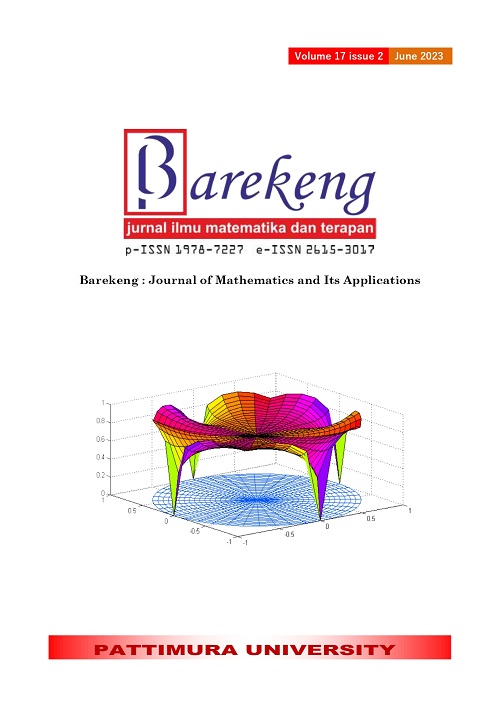MODELLING OF POVERTY PERCENTAGE IN EAST JAVA PROVINCE WITH SEMIPARAMETRIC REGRESSION APPROACH
Abstract
Poverty is an economic problem faced by all countries in the world, including Indonesia. Poverty is seen as the inability of a person from an economic standpoint to meet basic food and non-food needs as measured from the expenditure side. East Java Province is used as the object of research because this province has the highest economic growth in Java Island after DKI Jakarta province in the last 5 years. However, East Java is also included in the province with the highest number of poor people on the island of Java. Several independent variables that are thought to influence the percentage of poverty in East Java are the Open Unemployment Rate (TPT), Life Expectancy Rate (AHH), Average Years of Schooling (RLS), Population Density, and GRDP Rate. Sources of research data come from the East Java BPS website and East Java Open Data. Data analysis was performed using a semiparametric regression approach. The results of the analysis obtained good performance values, namely the MSE value of 12,2156 and the R2 value of 98,71%.
Downloads
References
N. Sakinah, H. Pudjianto, and U. J. Soedirman, “Determinants of Poverty in East Java Metropolitan Area in 2010-2016,” no. 26, pp. 32–40, 2016.
I. Introduction, “What ’ s Happened to Poverty and Inequality in Indonesia over Half a Century ?,” vol. 38, no. 1, pp. 68–97, 2021.
W. S. Report, INEQUALITY IN A RAPIDLY CHANGING. 2020.
P. N. Sambas, “Analysis of Poverty in Indonesia,” pp. 7368–7373, 2021.
I. Yulivan et al., “PT . PINDAD in Supporting The Defense Economy in East Java Indonesia,” no. 3, pp. 10–17, 2022, doi: 10.55683/jrbee.v4i3.375.
F. Adzim, S. Dian, W. Prajanti, M. I. Ekonomi, F. Ekonomika, and U. Diponegoro, “Assessing the Open Unemployment Rate in Bali : Regional Panel Data in Bali Evidence from,” vol. 10, no. 5, pp. 252–265, 2021.
M. Fisher, A. Maryudi, and M. A. K. Sahide, “Forest and Society : Initiating a Southeast Asia Journal for Theoretical , Empirical , and Regional Scholarship,” vol. 1, no. April, pp. 1–6, 2017.
H. R. Espacios, L. O. S. Autores, A. Asrol, and H. Ahmad, “Analysis of factors that affect poverty in Indonesia,” 2018.
P. O. Hakim I, Sunoko K, “Spatial territoriality in the Semanggi embankment area Spatial territoriality in the Semanggi embankment area,” 2020, doi: 10.1088/1755-1315/447/1/012029.
Voit E, Population Systems. New York, 2020. doi: 10.1016/B978-0-12-803033-2/00005-4.
F. Effect and R. E. Model, “THE EFFECT OF ECONOMIC GROWTH ON INCOME INEQUALITY :,” 2020.
U. F. Muhammad and J. David, “Relationship between Poverty and Unemployment in Niger State,” vol. 8, no. 1, pp. 71–78, 2019.
E. Science, “Impact of life expectancy , literacy rate , opened unemployment rate and gross domestic regional income per capita on poverty in the districts / city in Central Sulawesi Province Impact of life expectancy , literacy rate , opened unemployment rate and gro,” 2018.
A. M. Arsani, B. Ario, and A. F. Ramadhan, “Impact of Education on Poverty and Health : Evidence from Indonesia,” vol. 9, no. 6, 2020.
S. Van Der Berg, Poverty and education, 10th ed. Paris: UNESCO IIEP, 2008.
Copyright (c) 2023 Idrus Syahzaqi, Salman Alfarizi P. A., Kartika Fithriasari

This work is licensed under a Creative Commons Attribution-ShareAlike 4.0 International License.
Authors who publish with this Journal agree to the following terms:
- Author retain copyright and grant the journal right of first publication with the work simultaneously licensed under a creative commons attribution license that allow others to share the work within an acknowledgement of the work’s authorship and initial publication of this journal.
- Authors are able to enter into separate, additional contractual arrangement for the non-exclusive distribution of the journal’s published version of the work (e.g. acknowledgement of its initial publication in this journal).
- Authors are permitted and encouraged to post their work online (e.g. in institutional repositories or on their websites) prior to and during the submission process, as it can lead to productive exchanges, as well as earlier and greater citation of published works.






1.gif)



